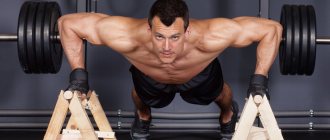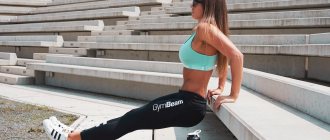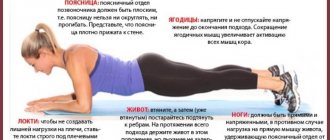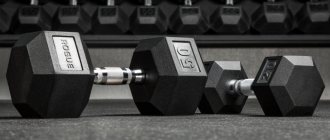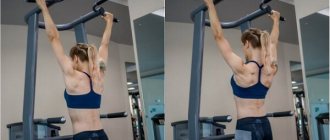Tips and tricks
Below we give some tips and recommendations on the technique of performing hanging lower limb lifts, which will help to avoid gross mistakes and wasted efforts for beginners and to perform the exercise efficiently for those whose sports training is at an average and higher level.
Basic mistakes of newbies
Beginners tend to make the following mistakes that should be avoided:
- strong swaying of the body and lifting of the lower limbs by inertia - when done this way, the exercise will bring absolutely no benefit;
- relaxation of the muscles of the shoulder girdle;
- helping with hands;
- improper breathing.
To avoid swinging, you need to learn to lower your legs smoothly and pause when they reach the lowest point.
About the features of the exercise and common mistakes:
Execution Features
When performing the exercise, you can use straps to secure your hands on the bar and elbow clamps. They will help you focus only on your abdominal muscles. The hands are not used during execution; they are relaxed and are used only for gripping. For maximum load on the oblique abdominal muscles, it is necessary to twist the body left and right - this is done with bent knees, which turn in different directions, rising each time. When lifting your legs, you need to tuck your pelvis - this will allow you to maximally tense your abdominal muscles. Inertia is unacceptable when performing this exercise. The ankle should rise and fall at each segment of the amplitude in the same amount of time. The lowering of the lower limbs should not be carried out completely - they should stop at the level of 15-25°. This way the abdominal muscles will remain tense throughout the entire exercise. It is not recommended to attach additional weights to your shins. The legs are a normal load to achieve the desired result. The chest must be kept open. If you feel pain in the lower back, you need to spread your toes and knees, while leaving your heels closed to each other. This should be more comfortable. If you cannot stabilize your body, you can ask a partner or instructor to hold you from behind. You need to look straight ahead. The chin resting on the chest is undesirable. At the end point of lifting your legs and after fixing them for two seconds, you need to additionally tense your abs. For beginners, it will be easier to do lifts of the lower extremities in a vertical position on the Swedish wall or parallel bars with a vertical back. The smaller the angle between the body and the hips, the greater the load on the abs. Raising your legs only parallel to the floor does not give any results to the abdominal muscles
It should be above an angle of 90°. A reverse grip on the bar is not recommended. The main attention should be paid not to raising the lower limbs, but to lowering them.
Execution technique
Don't try to keep your legs straight. It is necessary that your knees are slightly bent. This is done to avoid injury to the knee joints. If it is difficult for you to raise your legs straight, then raise your legs in a position where they are bent at the knees to an angle of approximately 90 degrees. Over time, when your muscles get stronger, you can gradually straighten your legs and then do the exercise with straight legs.
And if you didn’t have enough time for the third approach, then either do as much as you can, or supplement with the exercise “Lifting legs while lying on the floor,” on a bench, on any machine on which you can perform leg lifts while lying down. Breathing is the same as when lifting your legs while lying down, that is, when lifting your legs up, you need to exhale, and when lowering, inhale.
Leg raises can be performed hanging on a wall bars or on any other machine. This can be either an inclined board or any machine designed to perform this exercise.
Sets and reps
The principle of selecting the number of approaches and repetitions in these approaches remains as follows: in the first approach, you perform such a number of repetitions as to load your muscles to 60 or 70% of their maximum capabilities.
In the second approach, perform as many repetitions as possible. Well, in the third - how it turns out. In the future, you try to gradually increase the number of repetitions in all approaches. At least one repetition in one or even several classes. Then, when your muscles are strong enough, you can use weights.
Exercise technique
After jumping, you need to grab the bar. If you cannot reach it, you should use a stand or small bench. The main thing is not to touch the floor with your feet while hanging on straight arms. Use special straps if you have a weak grip. Straighten your arms completely, bend your back slightly at the waist. Exhale. You need to hold your breath, tense your abs, and try to raise your legs as high as possible, bending them at the knees. For sufficient stress on the abs, raise your knees above your waist.
At the top point, tighten your abdominal muscles as much as possible and hold in this position for 1-2 seconds. Exhale and lower your legs to the starting position, relaxing a little. After a short pause, repeat the exercise.
After fully mastering the technique, you can complicate the exercise: perform straight leg raises. At the same time, the load will increase both on the hip flexor muscles and on the lower part of the abs.
Recommendations
Start learning the exercise by lifting your legs, while bending them at the knees. But as you gain experience, do the exercise at a more advanced level - raise your legs while fixing the angle at your knees. Don't be embarrassed by the fact that this exercise works your hip flexors, as they are involved in all abdominal exercises. It is simply impossible to ensure that the load goes only to the abdominal muscles, without using the hip flexor muscles!
The legs in this exercise play the role of a lever, the length of which sets the level of load. To increase the load, you just need to straighten your legs more. If your quadriceps are strong enough and your hamstrings are elastic (stretch well), then to engage your abdominal muscles you will need to raise your knees much higher than your waist.
How to Do Lifts Effectively
- The slower the pace, the more strongly the rectus muscle will contract, and the less the quadriceps, so you need to lift your legs only very smoothly and under control;
- The principle of “exhaling for effort” works universally, it can also be used in abdominal training; we bring the pelvic bones to the lower ribs, exhaling;
- It is better to perform fewer repetitions, but slowly and in a controlled manner, rather than swinging your legs in the air 20 times;
- If you still have problems with your grip, you should use straps, or perform lifts in a “Roman chair”;
- Raising the legs in the parallel bars in gymnastics is a swing exercise, in fitness it is strictly controlled and on the abs, so if you want to work your core muscles, it is better to perform the movement with a stiff body and not swing your legs;
- For all its promise, this movement can and should be alternated with others. Beginners may have trouble hanging if they did deadlifts that day. When programming the training load, this must be taken into account. It is better to put hanging leg raises on the day when you train squats and bench presses, and variations, rather than rows and deadlifts, it will be easier to learn;
- If the movement only strains your IT band and quadriceps, switch to an easier option for a while. Perform leg raises while lying on the floor, slowly and pressing your lower back into the floor until you feel how much movement you need to make with your front abdominal wall to keep your back pressed throughout the movement. Transfer this experience to the crossbar;
- If you can’t get rid of inertia at all, you should switch to a simulator and perform the movement in support with your forearms. The back is pressed against the pillow, we remove excess mobility in the thoracic region. If there is kyphosis, you need to tighten the muscles more tightly to the center and lower the shoulder blades towards the spine, while simultaneously retracting the anterior abdominal wall;
- For informational purposes, those who cannot pull their stomach inwards are recommended to do a plank and a vacuum. These two exercises give the skill of assembling the center of the body under any load, and are useful for a beginner fitness enthusiast, but it will not be possible to progress in them for a long time. Do them as lift-ups, and then move on to hanging leg raises.
How to do it right
Drop Set is a technique used in strength training and bodybuilding. In the first phase of the exercise, the heaviest weight is used to gradually lower it. When doing a pull-up, the athlete clamps and holds a heavy dumbbell or kettlebell between his legs. This technique is aimed at maximizing muscle growth.
The following approaches to the horizontal bar are used in it:
- The first is to use the heaviest weight, for example 13–13.5 kg, with which the athlete gets tired after 4–6 repetitions and stops performing.
- Second - the weight is reduced by 2.5 kg, after which you need to do 8-10 pull-ups.
- Third - the weight is reduced by another two and a half kilos and 10-12 repetitions are done.
- The fourth is another weight reduction of 2.5 kg and another 12–15 repetitions.
- Fifth - here the weight is reduced at the discretion of the athlete (options: 2.5 kg or 5 kg), 15-20 pull-ups are performed. In the fifth approach, it is not necessary to adhere to the specified number of repetitions, but can be performed as many as the athlete is able to do.
There are many different types of pull-ups. You can place your hands close to each other on the bar, or create a wider grip. The wider the distance between the palms, the more the back muscles will work. For those who want a V-shaped back, it's best to work with a wide grip on each set.
We recommend learning how to properly perform negative pull-ups, as well as wide, parallel and reverse grip pull-ups.
The way you grip the bar will also affect which muscles are used.
Gripping with the palms facing away from the athlete is a pull-up involving the back muscles, and performing with the palms facing the person doing the exercise involves the biceps. Neither of these methods is better than the other, they are simply two different exercises that use a slightly different way to move different muscle groups when lifting body weight.
Important! Control your movements so that they are slow and smooth throughout the session. Let's look directly at the technique of pull-ups on the horizontal bar; it can be performed both with the use of weights of various weights and configurations, and without them:
Let's look directly at the technique of pull-ups on the horizontal bar; it can be performed both with the use of weights of various weights and configurations, and without them:
- Grab the bar with your hands, palms forward, with the space between your palms slightly wider than your shoulder width.
- Keep your legs slightly bent, kneecaps as close as possible.
- Concentrate on your back muscles and feel them contract as your arms lift your body up. There is no need to tuck your chin over the bar.
- When you pull yourself up, fix your position for a few seconds at the highest point of the lift, pressing your stomach against the bar.
- Pull yourself up slowly, mentally, slowly, counting to three, then freeze, squeezing your back muscles, then also slowly lower yourself to the count of three.
- Between reps, hang slightly from the bar, looking down and relaxing to allow your back muscles to move away from your shoulder blades and return to their rightful place.
As with other exercises, there are some errors in the pull-up that need to be addressed to make it safe and effective, including:
- Partial range of motion - the full length of the muscle needs to be developed, so always work from full extension at the elbow until your chin passes the bar.
- Lack of control when lowering - lowering the body down is as important as pulling it up, so after lifting the athlete should not allow the body to fall sharply down, so as not to injure the shoulder girdle.
- Jerky movements - do not use additional jerks, jumps or push-ups to pull yourself up, this can lead to strain in the muscles of the shoulders and back.
Did you know? Strength training equipment appeared in Europe and America in the sixties of the last century, but their demand increased in the 1970s, along with the fashion for bodybuilding and the popularity of bodybuilder Arnold Schwarzenegger.
Correct technique
There are several general rules for performing exercises on the bar to achieve maximum effect:
Pull-ups should be performed only using muscle strength, without swinging or using inertia; Lifting must be done smoothly and without jerking; At the top of the exercise, the chin should be above the bar; The body should also be lowered smoothly: the duration of the descent should be equal to the time of ascent; It is very important to breathe correctly: when ascending, exhale, when descending, inhale; Hold onto the bar as tightly as possible; Position the body strictly vertically.
Each type of exercise has its own nuances. If you perform pull-ups with a close grip, aim to touch the bar with your lower chest, looking at your hands.
When you do pull-ups behind your head with a wide grip, you don’t need to arch your back or make too sudden jerks: be careful not to get a skull injury.
When performing reverse-grip pull-ups, make sure that your shoulders are pulled back and your shoulder blades are pulled together.
When doing wide-grip pull-ups, perform the lift only using the latissimus dorsi muscles: at the top point, try to achieve contact between the chest and the bar.
When performing back exercises on the horizontal bar, “turn off” your biceps.
There are also special exercises on the horizontal bar for growth: it is believed that with their help you can achieve elongation of the body up to 5 cm. These exercises are performed in a free hang - the body is stretched to its full length under the influence of its own weight. From this position, movements are made with the legs: forward and backward, to the sides and back. You can also twist your body to the side and bend your legs at the knees. Height exercises help correct your posture, which can actually help increase your height.
A set of exercises on the horizontal bar for beginners should not include too many approaches and different exercises. You should always start small (1-2 types of exercises): the most important thing in doing pull-ups is not to rush anywhere. The slower you do the exercises, the better. When performed slowly, all necessary muscle groups are used and technique is improved.
Systematic exercises will allow you to develop endurance and strength, after which you can gradually increase the number of repetitions. After a few years of systematic training, you may well learn how to do pull-ups with one arm and do exercises with weights.
Pull-ups
General rules
1. Hold the bar firmly. Use a medium overhand grip: your hands grab the bar at shoulder level.
2. Avoid sudden movements or jerks. It’s better to do it once smoothly than three times with a jerk.
3. Each pull-up consists of 4 phases:
- Climbing (35% of the time)
- Fixation (15%)
- Descent (35%)
- Pause (15%)
3. When rising, your gaze should be directed upward to the sky or ceiling. The chin is slightly raised. It's like you're pulling yourself up to the bar with your chest.
4. At the top point, the chin should be above the bar.
5. Avoid slow lifting and sudden lowering. When lowering, you should, just as when lifting, use your muscles and not give in to the force of gravity. Lowering and rising should be the same in speed and duration.
6. Exhale - while lifting and fixing over the bar, inhale - during descent and pause.
7. Ideally, lifting is done without swinging or using the legs. At the initial level, you can close your eyes to this point.
Scheme of pull-ups on the horizontal bar from scratch
0. To start, simply hang from the bar.
Bend your back, look up at the bar and the sky (ceiling). Feel your body in this position.
1. First day
Our beginner pull-up program starts with simulating pull-ups.
Grabbing the bar, try to lift your body a little, pause a little and lower yourself down. The lowering is equal in time to the ascent and occurs smoothly. The essence of the simulation is to provide an opportunity to correctly perform a minimal pull-up without concentrating on achieving the goal. We monitor breathing, body position, direction of gaze and execution technique.
2. First week
During the first week, our pull-up routine from scratch involves the use of a chair or the assistance of a partner.
We do full pull-ups, but with partial weight. For this purpose we use, for example, a stool, chair or any other elevation. The point is that part of the weight falls on the auxiliary object. To do this, you need to bend your legs at the knees and rest on an auxiliary object with your fingers or lifting your legs. The same function can be performed by a partner who will hold the legs at the shin or ankle.
As part of this stage of the program for beginners on pull-ups on the horizontal bar, we train daily or every other day. We perform 5-8 repetitions in 3 approaches.
3. Second week
Our zero bar pull up program in week two focuses on half pull ups or learning how to lower properly.
The half pull-up is also known as the negative pull-up. We can call it negative because Pull-ups like this don’t happen: we train not to drop sharply.
Holding the bar with our hands and pushing off the ground with our feet, we assume a position as if we had pulled ourselves up. We fixate: the chin is above the bar, the gaze is directed upward, the chest almost touches the bar. Then we lower ourselves smoothly.
We perform 5-8 negative pull-ups in 3 approaches.
4. Third week
In the third week of the pull-up scheme on the horizontal bar from scratch, we alternate exercises with the help of an auxiliary object or a partner and a negative version. If pull-ups are easy, increase the number of repetitions to 15-20.
It shouldn't be easy. It must be a load that can be overcome with effort.
The more perfect you are at doing light pull-ups in week three, the more successful you will be at doing full pull-ups.
5. Fourth week. Full pull-ups.
The previous three weeks of the beginner's pull-up program were necessary for the body to get used to physical activity and “understand” in which direction it needs to adjust. For a person who starts pull-ups on the horizontal bar from scratch, the issue of physiological adjustment is extremely important. After all, instead of sitting, you are going to build muscle mass. For our body, this is a completely different way of working.
Follow the general rules for pull-ups that we gave above.
Alternate between forward and reverse grips every day. Don't do them together in the same workout.
Start with the maximum number of pull-ups you can do. 3 pull-ups is very good. Do 3 approaches. It's okay if on the third approach you only do 1 pull-up. As soon as the number of repetitions in the first and last set is equal, add 1 extra repetition. Continuing the program from zero pull-ups on the horizontal bar, over time your muscles will get stronger, and the number of repetitions will increase to 5, 10, 15, 20.
Main complex
The main load when pulling up the legs on the horizontal bar falls on the rectus abdominis muscle. Unlike crunches, the nerve endings that cause the muscle to contract act directly on the lower part of the rectus muscle.
Training program for different levels of training. Table.
Other muscles also work during this exercise:
- tailoring;
- iliopsoas;
- scallop
The oblique is almost not involved if you perform the exercise without moving your legs to the sides.
Corner leg raise
This exercise is called so because of the position of the body at the peak point.
Raising legs on the horizontal bar. Exercise "Corner".
It is done like this:
- grab the horizontal bar crossbar tightly with your hands, look straight ahead, body vertical to the ground, legs together;
- slowly raise your legs up so that they reach the level of parallel with the floor, only the hip joint should move;
- exhaling, linger at the peak point for a couple of seconds, and then slowly lower your legs to the starting point.
The width of the arms is set so that you can hang as long as possible. Typically, this exercise uses an overhand grip, with your palms facing forward and your hands placed on the bar, shoulder-width apart.
Knee Raise
This option for performing the exercise on the horizontal bar is the most common. Simple execution allows it to be used in training beginners and experienced athletes.
Technically it works like this:
- grab the bar with your hands, your body should be straight, your legs should be brought together;
- slowly bend your knees, lifting them up until your thighs are parallel to the floor and your shins are perpendicular;
- at the highest point it will stop for 1-2 seconds and slowly return to its original position.
At the peak point, exhale to empty your lungs of air and tighten your abdominal muscles as much as possible.
Lifting limbs directly to the bar
This exercise is popular in CrossFit. Its advantage is that the abdominal muscles contract to the maximum.
Technically it works like this:
- grab the bar tightly, hands shoulder-width apart, back perfectly straight, legs together;
- slowly raise your legs to the bar and at the same time turn your pelvis inward;
- bring your feet to the bar, touching it with your toes;
- return to the starting point.
There is no pause at the top point, but all because of the extreme straining at the peak point. Perform the exercise as slowly as possible, without jerking.
Lifting with body tucking
During this exercise, the main load falls on the transverse, internal and external oblique muscles.
Technically it works like this:
- firmly grasp the horizontal bar with your hands, hands no wider than shoulders, palms facing forward;
- slowly raise your knees up, lifting your hips up to one side;
- take the starting position;
- raise your knees again, lifting your hips, on the other side of the body;
- return to the starting point again.
Leg raises on the horizontal bar with a ball between the legs
This option is suitable for experienced athletes who want to diversify their training process.
Technically, the exercise is performed like this:
- firmly grasp the crossbar of the exercise machine with your hands, while between your legs, below the knees, you need to hold a weighted ball; you can use a dumbbell as a weighting agent;
- after exhaling, you need to slowly raise your legs, slightly bending them at the knees, to the maximum allowable height;
- fix the body at the highest point for 2-3 seconds;
- slowly lower your legs, aligning your body.
By holding the ball between your legs, you can get additional load. If you properly develop a training program, you can not only build muscle mass and make your abdominal muscles more pronounced.
Alternating leg raises
This option is suitable for those who want to diversify the training process. It differs from the classic lift in that it manages to combine dynamic and static loads. Raising one leg to the height of a right angle, part of the press performs dynamic work, and the second part does statistical work, responsible for ensuring that the body is in a stable position. While performing this exercise, you need to monitor the position of your lower back.
Do not bring the sacral area forward too much, as the spine will twist.
Lifting with inversion
Technically this option works like this:
- hang with a straight grip, hands slightly wider than shoulder-width apart;
- slowly perform straight leg raises and pull-ups;
- then sharply raise your legs up, throwing them onto the crossbar;
- traction occurs towards the center of the torso;
- the revolution occurs at the moment when the mass of the legs is outweighed and they begin to fall down, pulling the body upward;
- when rotated, the crossbar is located at waist level;
- when the legs are lowered, the athlete returns to the starting position - hanging on the horizontal bar.
Tips for training on the horizontal bar
If you've been following the above programs but haven't noticed any significant changes in your fitness, don't get discouraged. These guidelines will help you reach your full potential.
Technical nuances
Keep an eye on your technique. When performing pull-ups on the bar, focus the load on the back muscles, not on the arms. To better feel the contraction and stretching of the latissimus muscles, use wrist straps. Try to lower your shoulders a little, this way you will “free up” the trapezius and rhomboid muscles, and your back will receive more load. If your grip is the weakest link in your chain, pay more attention to your hang on the bar. You can use additional weights by hanging a weight or disk on a chain from your belt. Another option is to use a towel. Hanging on it perfectly develops the strength of the forearms. You can also wrap a towel around the bar to make it wider - this will strengthen your hands and increase finger strength. It is recommended to use magnesium, this will make holding the horizontal bar much more comfortable, and your grip is unlikely to let you down. Extinguish the force of inertia. Do not deceive yourself - each repetition must be performed under control. They should all be “clean”; you shouldn’t squirm your whole body to pull yourself up. There is no point in this. It is better to do fewer repetitions, but technically correct, the benefits will be much greater. Try to maintain a consistent pace of exercise. This will make it easier to use the neuromuscular connection and focus on stretching and contracting the muscles. This applies to all exercises performed with your own weight.
However, this does not mean that the faster the better. If you are still a beginner and the training program we have indicated is difficult for you, pay attention to practicing auxiliary exercises. Do back exercises on blocks in the gym - this way you will become stronger and pull-ups will be much easier
Another option is to use a partner's help. Let him push you up a little while doing pull-ups, thereby making the task easier. After some time, you will be able to safely do pull-ups on your own. The third option is to do partial pull-ups. Over time, you will understand the biomechanics of movement and will be able to easily overcome sticking points and perform pull-ups at full amplitude. The last option is pull-ups in a gravitron. This is an excellent machine that helps you do pull-ups using a counterweight, the resistance of which can be changed as your strength increases. Watch your diet. It is not enough for muscles to stimulate growth through strength training; they need resources for recovery and subsequent hypertrophy. Therefore, a calorie surplus, sufficient protein intake (about 2 g per kg of weight) and complex carbohydrates (from 4 g per kg) are necessary.
Safety of the training process
- Be careful when performing head pull-ups. Many athletes do not have enough flexibility to fully perform this exercise, which causes damage to the joints and ligaments of the shoulder. Roughly the same story is associated with two similar exercises: the barbell overhead press and the vertical block row behind the head.
- If you feel discomfort while performing any exercise, give it up. It is better to replace this element with something more comfortable, but with a load on similar muscle groups.
- Don't forget to do a thorough joint warm-up before training. Pull-ups, muscle-ups, and hanging leg raises involve almost all the muscles of the core, so the warm-up should be appropriate. Thoroughly stretch your wrists and rotator cuff to minimize the risk of injury. Do several sets of forward bends to properly stretch your lower back. Don't be afraid to spend 10-15 minutes warming up - your muscles, joints and ligaments will thank you for it.
And in conclusion, one more important piece of advice: decide on your individual training frequency. You should not train every day, bringing your body to exhaustion and exhaustion. This is fraught not only with overtraining, but also with injuries. 3-4 sessions per week will be enough to achieve any sports goals.
Author Ivan Tungusov
Project expert. Training experience - 12 years. A good theoretical basis on the training process and proper nutrition, which I am happy to put into practice. Need a recommendation? This is for me
